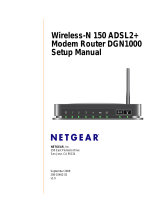
6 Getting to Know Your Wireless Router
• Away from electrical devices which are potential sources of interference, such as ceiling fans,
home security systems, microwaves, or the base for a cordless phone.
• Away from any large metal surfaces, such as a solid metal door or aluminum studs. Large
expanses of other materials such as glass, insulated walls, fish tanks, mirrors, brick, and
concrete can also affect your wireless signal.
Installing Your Wireless Router
To help you set up your router and get on the Internet quickly, the Resource CD contains a Smart
Wizard™ Installation Assistant. The Installation Assistant walks you through the steps required to
connect your router, modem, and PC(s); configure your wireless settings; and enable wireless
security for your network. When you have finished, you will be Internet ready!
You can set up your wireless router using one of two methods:
• Smart Wizard Setup: The Smart Wizard Installation Assistant setup is available on your
Resource CD. See “Installing Your Router Using the Smart Wizard” on page 9 to use the
Smart Wizard Installation Assistant.
– This is the easiest option. The wizard guides you through the setup process. It automates
many of the steps and verifies that the steps have been successfully completed.
– Smart Wizard requires a PC running Microsoft Windows.
• Manual Setup: If you cannot or prefer not to use the Smart Wizard Installation Assistant, see
“Manually Installing Your Router” on page 13. For example, if you are connecting to a Mac,
are using a Linux operating system, or are technically knowledgeable, select this option. If you
choose to use this option and install your router manually, for best results, install and set up
your router in this order:
Failure to follow these guidelines can result in significant performance degradation
or an inability to wirelessly connect to the Internet.
NETGEAR does not recommend or support adding a NETGEAR router behind
another router, or replacing a gateway with a a NETGEAR router.
If you have a Macintosh or Linux system, you must use the manual installation
method (see “Manually Installing Your Router” on page 13).




















